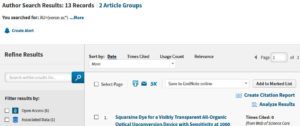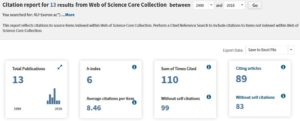This post is also available in:
 Deutsch
Deutsch
The h-index, proposed by Hirsch in 2005, is a measure to calculate the output of a researcher. With an h-index of 10, 10 publications of an author are cited at least 10 times. This value can be calculated in the database Web of Science Core Collection.
Additional search tools that calculate the h-index are Scopus or Google Scholar.
However, the h-index is not entirely uncontroversial and has certain advantages and disadvantages.
| Advantages | Disadvantages |
|---|---|
| - considers only most cited publications - eliminates “one-hit wonder” - “punishes” authors, who are little/not cited but publish much | - 'Groundbreaking' works are not being duly appreciated - Influenced by career duration - Compare only within the same discipline! (Depends from the research field) - depends on which publications of a researcher are indexed in the search tools. |




